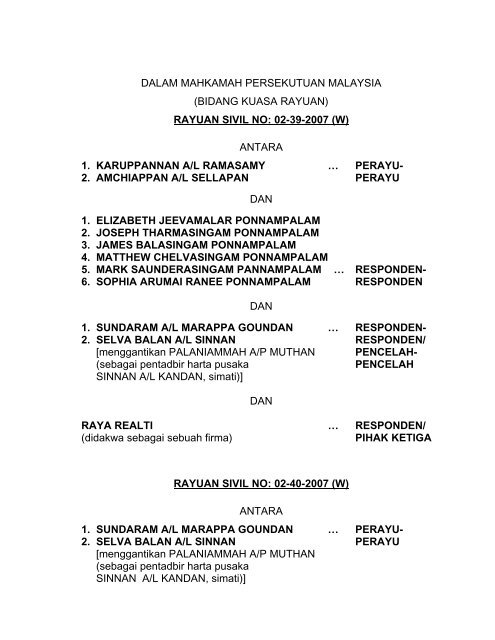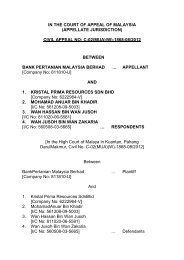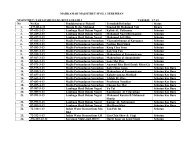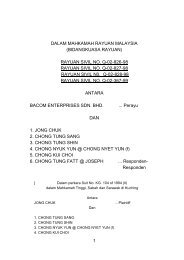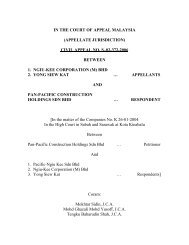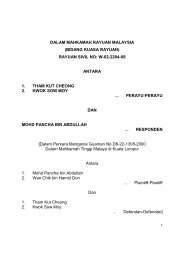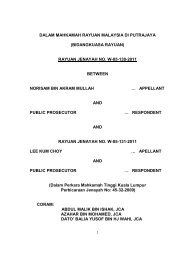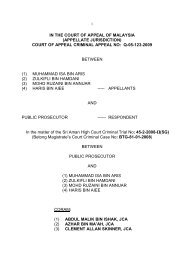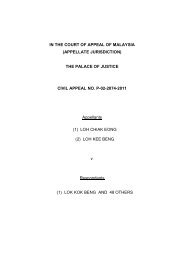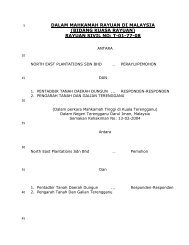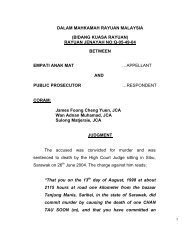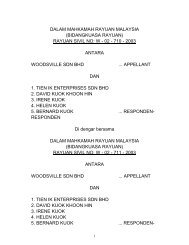rayuan sivil no: 02-39-2007 (w)
rayuan sivil no: 02-39-2007 (w)
rayuan sivil no: 02-39-2007 (w)
You also want an ePaper? Increase the reach of your titles
YUMPU automatically turns print PDFs into web optimized ePapers that Google loves.
DALAM MAHKAMAH PERSEKUTUAN MALAYSIA<br />
(BIDANG KUASA RAYUAN)<br />
RAYUAN SIVIL NO: <strong>02</strong>-<strong>39</strong>-<strong>2007</strong> (W)<br />
ANTARA<br />
1. KARUPPANNAN A/L RAMASAMY … PERAYU-<br />
2. AMCHIAPPAN A/L SELLAPAN PERAYU<br />
DAN<br />
1. ELIZABETH JEEVAMALAR PONNAMPALAM<br />
2. JOSEPH THARMASINGAM PONNAMPALAM<br />
3. JAMES BALASINGAM PONNAMPALAM<br />
4. MATTHEW CHELVASINGAM PONNAMPALAM<br />
5. MARK SAUNDERASINGAM PANNAMPALAM … RESPONDEN-<br />
6. SOPHIA ARUMAI RANEE PONNAMPALAM RESPONDEN<br />
DAN<br />
1. SUNDARAM A/L MARAPPA GOUNDAN … RESPONDEN-<br />
2. SELVA BALAN A/L SINNAN RESPONDEN/<br />
[menggantikan PALANIAMMAH A/P MUTHAN PENCELAH-<br />
(sebagai pentadbir harta pusaka PENCELAH<br />
SINNAN A/L KANDAN, simati)]<br />
DAN<br />
RAYA REALTI … RESPONDEN/<br />
(didakwa sebagai sebuah firma) PIHAK KETIGA<br />
RAYUAN SIVIL NO: <strong>02</strong>-40-<strong>2007</strong> (W)<br />
ANTARA<br />
1. SUNDARAM A/L MARAPPA GOUNDAN … PERAYU-<br />
2. SELVA BALAN A/L SINNAN PERAYU<br />
[menggantikan PALANIAMMAH A/P MUTHAN<br />
(sebagai pentadbir harta pusaka<br />
SINNAN A/L KANDAN, simati)]
2<br />
DAN<br />
1. ELIZABETH JEEVAMALAR PONNAMPALAM<br />
2. JOSEPH THARMASINGAM PONNAMPALAM<br />
3. JAMES BALASINGAM PONNAMPALAM<br />
4. MATTHEW CHELVASINGAM PONNAMPALAM<br />
5. MARK SAUNDERASINGAM PANNAMPALAM … RESPONDEN-<br />
6. SOPHIA ARUMAI RANEE PONNAMPALAM RESPONDEN<br />
[ DALAM MAHKAMAH RAYUAN MALAYSIA<br />
(BIDANG KUASA RAYUAN)<br />
RAYUAN SIVIL NO: W-<strong>02</strong>-728-2003<br />
ANTARA<br />
1. ELIZABETH JEEVAMALAR PONNAMPALAM<br />
2. JOSEPH THARMASINGAM PONNAMPALAM<br />
3. JAMES BALASINGAM PONNAMPALAM<br />
4. MATTHEW CHELVASINGAM PONNAMPALAM<br />
5. MARK SAUNDERASINGAM PANNAMPALAM … PERAYU-<br />
6. SOPHIA ARUMAI RANEE PONNAMPALAM PERAYU<br />
DAN<br />
1. KARUPPANNAN A/L RAMASAMY … RESPONDEN-<br />
2. AMCHIAPPAN A/L SELLAPAN RESPONDEN<br />
DAN<br />
1. SUNDARAM A/L MARAPPA GOUNDAN … RESPONDEN-<br />
2. PALANIAMMAH A/P MUTHAN RESPONDEN/<br />
(sebagai pentadbir harta pusaka PENCELAH-<br />
SINNAN A/L KANDAN, simati) PENCELAH<br />
DAN<br />
RAYA REALTI … RESPONDEN/<br />
(didakwa sebagai sebuah firma) PIHAK KETIGA ]
3<br />
[ Dalam Mahkamah Tinggi Malaya di Kuala Lumpur<br />
Guaman Sivil No: S3-22-118-1995<br />
ANTARA<br />
1. KARUPPANNAN A/L RAMASAMY … PLAINTIF-<br />
2. AMCHIAPPAN A/L SELLAPAN PLAINTIF<br />
DAN<br />
1. SUNDARAM A/L MARAPPA GOUNDAN … PENCELAH/<br />
2. PALANIAMMAH A/P MUTHAN PENCELAH<br />
(sebagai pentadbir harta pusaka (yang mencelah<br />
SINNAN A/L KANDAN, simati) sebagai Plaintif)<br />
DAN<br />
1. ELIZABETH JEEVAMALAR PONNAMPALAM<br />
2. JOSEPH THARMASINGAM PONNAMPALAM<br />
3. JAMES BALASINGAM PONNAMPALAM<br />
4. MATTHEW CHELVASINGAM PONNAMPALAM<br />
5. MARK SAUNDERASINGAM PANNAMPALAM<br />
6. SOPHIA ARUMAI RANEE PONNAMPALAM … DEFENDAN-<br />
7. RAYA REALTI DEFENDAN<br />
(didakwa sebagai sebuah firma)<br />
DAN<br />
RAYA REALTI … PIHAK KETIGA ]<br />
(didakwa sebagai sebuah firma)<br />
Coram<br />
ZAKI TUN AZMI, CJ<br />
ALAUDDIN DATO’ MOHD SHERIFF, PCA<br />
ABDUL AZIZ MOHAMAD, FCJ<br />
JUDGMENT OF THE COURT
4<br />
1. This case concerns a land in Cameron Highlands measuring 12 acres<br />
2 roods 2 poles (12.5125 acres) belonging to six persons who became<br />
defendants in this case and who will therefore be referred to as “the six<br />
defendants”. On 5 October 1988 they appointed Raya Realti, a firm of real<br />
estate agents, to sell the land at RM30,000 per acre.<br />
2. On 9 October 1988 Raya Realti gave to two persons a written option<br />
to purchase the land at RM28,000 per acre. The option was to be exercised<br />
by 18 October 1988 by paying ten per cent of the total purchase price. The<br />
total purchase price was <strong>no</strong>t stated in the option, but since the land<br />
measures 12.5125 acres, the total purchase price would be RM350,350,<br />
and ten per cent of it would be RM35,035. The two persons were<br />
Sundaram a/l Marappa Goundan and Sinnan a/l Kandan. The option given<br />
to them will be referred to as “the first option”.<br />
3. On 10 October 1988 Raya Realti gave to two other persons a<strong>no</strong>ther<br />
written option to purchase the same land at RM28,000 per acre. The option<br />
was to be exercised by 25 October 1988 by paying ten per cent of the total<br />
purchase price, which would also be RM35,035. The two persons were<br />
Karuppannan a/l Ramasamy and Amchiappan a/l Sellapan. As they<br />
became the plaintiffs in this case, they will be referred to as “the plaintiffs”.<br />
The option given to them will be referred to as “the second option”.<br />
4. On 15 October 1988, five days after obtaining the option, the plaintiffs<br />
lodged a private caveat on the land.<br />
5. On 19 October 1988 the solicitors for the six defendants, Skrine & Co.,<br />
returned two cheques to Raya Realti for onward transmission to the<br />
aforesaid Sundaram and Sinnan, holders of the first option, saying in their
5<br />
letter that their clients were <strong>no</strong>t proceeding with the sale of the land unless<br />
and until the plaintiffs’ private caveat was removed. The two cheques<br />
totalled RM35,000, each being for RM17,500, and were cheques for paying<br />
ten per cent of the total purchase price.<br />
6. On 4 November 1988 the plaintiffs, maintaining that before 25 October<br />
1988, the date of expiry of the second option, they had paid to Raya Realti<br />
slightly more than ten per cent of the total purchase price, namely,<br />
RM36,400, and alleging that the six defendants and Raya Realti had<br />
refused to complete the agreement for sale, brought an action against the<br />
six defendants and Raya Realti, who became the seventh defendant, for<br />
specific performance, or, alternatively, for damages for breach of contract.<br />
Against the plaintiffs’ claim, the six defendants pleaded as their defences<br />
that the giving of the option was <strong>no</strong>t done in the course of Raya Realti’s<br />
employment as their agent, that Raya Realti were <strong>no</strong>t authorized to sell the<br />
land at a price lower than RM30,000 per acre, that the option given to the<br />
plaintiffs was a conditional option because before granting it Raya Realti<br />
had represented to them that it was subject to the prior rights of Sundaram<br />
and Sinnan under the first option, and that the plaintiffs did <strong>no</strong>t exercise the<br />
option before its expiry on 25 October 1988. The six defendants<br />
counterclaimed against the plaintiffs for removal of their caveat and for<br />
damages on account of the caveat.<br />
7. In June 1991, by way of third-party proceedings, the six defendants<br />
brought a claim against Raya Realti for damages for granting to the plaintiffs<br />
the second option to sell the land at RM28,000 per acre whereas the<br />
authorized price was RM30,000 per acre and for granting the option when<br />
there was already a valid option, the first option, granted to Sundaram and<br />
Sinnan. Sinnan had died in January 1991.
6<br />
8. In 1998, when the trial of the action had proceeded a little way,<br />
Sundaram and Sinnan’s widow, Palaniammah a/p Muthan, as administrator<br />
of Sinnan’s estate, came into the action as intervener-plaintiffs and filed<br />
their statement of claim, which was against the six defendants, on 2 July<br />
1998. For convenience, we will speak of the intervener-plaintiffs as referring<br />
also to Sinnan. The intervener-plaintiffs contended, inter alia, that the option<br />
given to them, the first option, had been exercised before its expiry on 18<br />
October 1988 by the payment of RM35,000 on 9 and 15 October 1988, and<br />
averred that the six defendants <strong>no</strong> longer wished to proceed with the sale of<br />
the land. The intervener-plaintiffs prayed for an order of specific<br />
performance against the six defendants. Against the intervener-plaintiffs’<br />
claim, the defences that the six defendants pleaded were essentially that<br />
Raya Realti were <strong>no</strong>t their agent, or, alternatively, that Raya Realti were <strong>no</strong>t<br />
authorized to sell the land at a price lower than RM30,000 per acre.<br />
9. In January 1999, by way of third-party proceedings, the six defendants<br />
brought a claim against Raya Realti for damages for granting to the<br />
intervener-plaintiffs the first option when they were <strong>no</strong>t an agent or<br />
employee of the six defendants or, alternatively, for granting the option to<br />
purchase at RM28,000 per acre whereas the authorized price was<br />
RM30,000 per acre.<br />
10. The learned trial judge found, as regards the plaintiffs’ claim, that they<br />
had exercised the second option before the deadline of 25 October 1988 by<br />
paying RM34,600 into Raya Realti’s bank account and that therefore there<br />
was a concluded contract. The learned judge did <strong>no</strong>t deal with the defence<br />
as to Raya Realti’s authority but we would assume, from the finding of a<br />
concluded contract, that he accepted that Raya Realti had the six<br />
defendants’ consent to sell the land at RM28,000 per acre.
7<br />
11. As regards the intervener-plaintiffs’ claim, the learned trial judge<br />
specifically found as a fact that the six defendants agreed to the price of<br />
RM28,000 per acre, thereby impliedly finding that Raya Realti were the six<br />
defendants’ agent. He found there was a concluded contract.<br />
12. The learned trial judge therefore found that the six defendants were<br />
liable both to the plaintiffs and the intervener-plaintiffs for breach of contract,<br />
but since it was the intervener-plaintiffs who were the first to be given an<br />
option, he ordered specific performance against the six defendants in favour<br />
of the intervener-plaintiffs and only awarded damages for the plaintiffs<br />
against the six defendants and also against Raya Realti the seventh<br />
defendant. He consequently dismissed the six defendants’ third-party<br />
claims against Raya Realti and counterclaim against the plaintiffs as<br />
regards the caveat.<br />
13. The six defendants appealed to the Court of Appeal against the entire<br />
decision of the High Court, that is to say, the orders made against them in<br />
favour of the plaintiffs and the intervener-plaintiffs and the consequent<br />
dismissal of their third-party claims against Raya Realti and counterclaim<br />
against the plaintiffs. The plaintiffs cross-appealed for specific performance.<br />
Raya Realti cross-appealed against the award of damages against them as<br />
the seventh defendant in favour of the plaintiffs.<br />
14. The Court of Appeal found there was <strong>no</strong> binding or concluded contract<br />
in favour of the plaintiffs and intervener-plaintiffs and therefore allowed the<br />
six defendants’ appeal and set aside the award of damages and the order of<br />
specific performance. Consequently the appeal on their counterclaim<br />
against the plaintiffs was allowed and the plaintiffs’ private caveat was<br />
ordered to be removed and damages on account of the private caveat were
8<br />
ordered, and the plaintiffs’ cross-appeal for specific performance was<br />
dismissed. The Court of Appeal dismissed the six defendants’ appeal<br />
against the dismissal of their third-party claims against Raya Realti, finding<br />
that in any case they had apparent or ostensible authority to bind the six<br />
defendants to a lower price of RM28,000 per acre. The Court of Appeal<br />
made <strong>no</strong> mention in their judgment of Raya Realti’s cross-appeal against<br />
the award of damages against them in favour of the plaintiffs.<br />
15. Only the plaintiffs and intervener-plaintiffs applied for and obtained<br />
leave to appeal to this court. The plaintiffs’ appeal is appeal No. <strong>39</strong>, and is<br />
directed also against the dismissal of their counterclaim for specific<br />
performance, and the intervener-plaintiffs’ appeal is appeal No. 40. There is<br />
<strong>no</strong> appeal by the six defendants, so that the question of their third-party<br />
claims against Raya Realti does <strong>no</strong>t arise in the present appeals. The<br />
plaintiffs’ appeal is directed against the six defendants only, so that the<br />
question of damages for the plaintiffs against Raya Realti does <strong>no</strong>t arise in<br />
the present appeals. In short, as their counsel, who was present during the<br />
hearing of the appeals, said, Raya Realti are <strong>no</strong>t jeopardized by these<br />
appeals.<br />
16. After the appeals had reached this court the second intervener-<br />
plaintiff, the widow and administrator of the estate of Sinnan, died on 2<br />
October 2008, and their son, Selva Balan a/l Sinnan, has <strong>no</strong>w been<br />
substituted as the second intervener-plaintiff-appellant.<br />
THE INTERVENER-PLAINTIFFS’ APPEAL<br />
17. We shall deal first with the intervener-plaintiffs’ appeal. For this<br />
appeal, the following facts need to be set out, some of which have been<br />
mentioned earlier.
9<br />
18. The intervener-plaintiffs’ option, the first option, was dated 9 October<br />
1988. It was to be exercised by 18 October 1988 by paying ten per cent of<br />
the total purchase price, which, although this was <strong>no</strong>t stated in the option,<br />
would come to RM350,350. Ten per cent of that would strictly be<br />
RM35,035. A cheque for RM17,500 was ack<strong>no</strong>wledged in the option as<br />
having been received. It was in the name of Raya Realti, the six<br />
defendants’ agent. It was dated 9 October 1988. A<strong>no</strong>ther cheque of the<br />
same date, also for RM17,500, was issued in the name of Skrine & Co., the<br />
six defendants’ solicitors. The cheque in the name of Raya Realti was paid<br />
into Raya Realti’s client’s account and Raya Realti issued a client’s account<br />
cheque dated 15 October 1988 for RM17,500 in the name of Skrine & Co.<br />
By 15 October 1988, therefore, Skrine & Co. were in possession of two<br />
cheques for RM35,000 on behalf of the six defendants. It was RM35 less<br />
than the exact ten per cent of the total purchase price. That was three days<br />
before the last date for the intervener-plaintiffs to exercise the option. On 19<br />
October 1988 Skrine & Co. returned the two cheques to Raya Realti, saying<br />
that the six defendants were <strong>no</strong>t proceeding with the sale unless and until<br />
the plaintiffs’ private caveat was removed.<br />
19. The intervener-plaintiffs obtained leave to appeal on three leave-<br />
questions. It is expedient to deal first with Questions 2 and 3.<br />
Questions 2 and 3<br />
20. These relate to the deficiency of RM35 and are as follows:<br />
“2. Whether an acceptance by the vendor of a sum that<br />
is marginally less than the strict calculation of 10%<br />
of the purchase price constitutes a waiver of the<br />
marginal difference and estops the vendor from<br />
raising the said <strong>no</strong>n-payment of the said marginal<br />
difference as a defence to specific performance;
10<br />
3. Whether in any case, the de minimis rule applies to<br />
such a marginal difference.”<br />
21. The question of the deficiency was <strong>no</strong>t raised in the six defendants’<br />
defence or during the trial and <strong>no</strong> evidence was led on it. It was raised only<br />
during submission. The trial judge ig<strong>no</strong>red it. He only dealt with the six<br />
defendants’ pleaded defences as to Raya Realti’s status and authority,<br />
which were their only pleaded defences. The Court of Appeal, however,<br />
said concerning the deficiency: “It is settled law that an Option is a unilateral<br />
contract which does <strong>no</strong>t become binding on the grantor of the Option until<br />
the exact terms of the Option are complied with”.<br />
22. The intervener-plaintiffs’ counsel went to great lengths to point out<br />
various circumstances to persuade us that they show that the parties had<br />
always proceeded on the basis that the sum of RM35,000 was acceptable<br />
as full satisfaction of ten per cent of the total purchase price. We will <strong>no</strong>t set<br />
out the circumstances and will only say that it is clear to us that that was the<br />
case. They amounted to a waiver of the RM35. If that had <strong>no</strong>t been the<br />
case the six defendants would have raised the deficiency as a defence. We<br />
wish particularly to mention that on 9 October 1988 Raya Realti, in<br />
forwarding to Skrine & Co. the cheque for RM17,500 in their name, also<br />
forwarded, in a form, the particulars of the vendor and purchaser. In that<br />
form the purchase price was given as “$350,000 (Approx)” and the deposit<br />
was given as “$35,000 (10%) (Approx)”. It is a clear indication that Raya<br />
Realti, as the six defendants’ agent, were <strong>no</strong>t concerned to fix the deposit at<br />
the exact sum of RM35,035.
11<br />
23. We would therefore answer Question 2 in the affirmative. There is <strong>no</strong><br />
need to answer Question 3 to decide in favour of the intervener-plaintiffs the<br />
question of the deficiency.<br />
Question 1<br />
24. This question is as follows:<br />
“Whether after the grant of an option to purchase land a<br />
vendor can unilaterally repudiate the option, after the due<br />
exercise of the option, on the ground that the caveat has<br />
been lodged by a third party.”<br />
25. It arose from the following statement in the Court of Appeal’s<br />
judgment:<br />
“I am also of the view that the returning of the two<br />
cheques . . . by Messrs. Skrine & Co. to [Raya Realti] vide<br />
their letter dated 19.10.1988 would show that there was<br />
<strong>no</strong> acceptance of the ten per cent deposit.”<br />
As has been stated, those cheques were returned because the six<br />
defendants did <strong>no</strong>t wish to proceed with the sale because of the presence of<br />
the plaintiffs’ private caveat.<br />
26. In our judgment, provided the option had been exercised in time, there<br />
was a binding contract, and the lodging of the caveat did <strong>no</strong>t entitle the six<br />
defendants to refuse to proceed with the sale. All that the intervener-<br />
plaintiffs had to do to exercise the option and turn it into a binding or<br />
absolute contract was to tender payment of the ten per cent deposit by 18<br />
October 1988. This they did. That the six defendants’ solicitors chose <strong>no</strong>t<br />
to bank in the cheques but instead to return them to Raya Realti did <strong>no</strong>t<br />
change the fact that the option had been exercised. We respectfully<br />
disagree with the Court of Appeal that the return of the cheques signified <strong>no</strong><br />
“acceptance” of the ten per cent deposit.
27. We therefore allow the intervener-plaintiffs’ appeal.<br />
THE PLAINTIFFS’ APPEAL<br />
12<br />
28. It was on three grounds that the Court of Appeal found that there was<br />
<strong>no</strong> concluded contract and set aside the orders of the High Court in favour<br />
of the plaintiffs. Each of the three grounds gave rise to a leave-question, so<br />
that there are three leave-questions.<br />
Question 1<br />
29. Question 1 is as follows:<br />
“1. When a sale and purchase of land is by way of an<br />
oral agreement and such transaction is done through<br />
an option to purchase whether such an option to<br />
purchase can be treated merely as evidence which<br />
does <strong>no</strong>t require to be specifically pleaded.”<br />
30. We wish to say at the outset that it is clear to us that, on the evidence,<br />
it was only on the second option dated 10 October 1988 that the plaintiffs<br />
could base their claim against the six defendants. The option contained<br />
sufficient essential terms for it, in ordinary circumstances, to become a<br />
binding or absolute contract upon payment of the required sum by the due<br />
date, whether or <strong>no</strong>t a formal and elaborate sale and purchase agreement<br />
was to follow.<br />
31. The plaintiffs, however, in their brief seven-paragraph statement of<br />
claim, did <strong>no</strong>t plead the option as the basis of their claim but pleaded<br />
instead an oral agreement of the same date and terms as to price and<br />
payment of ten per cent of the total purchase price as in the option. This<br />
may be seen in paragraphs 3 and 4 of the statement of claim. But there<br />
was <strong>no</strong> evidence of any oral agreement. There was only the option, the
13<br />
second option. It would appear as though the drafter of the statement of<br />
claim treated the option as an oral agreement, because if references to the<br />
alleged oral agreement throughout the statement of claim were to be<br />
substituted with references to the option, the statement of claim would<br />
reflect the actual position.<br />
32. The six defendants, however, knew that they had to answer a claim<br />
based on the second option. This may be seen in their reply to paragraph 6<br />
of the statement of claim where the plaintiffs averred that, despite requests<br />
by the plaintiffs, the six defendants failed to take any steps towards<br />
completion of “the said agreement”, which, according to the statement of<br />
claim, was the alleged oral agreement. The six defendants’ reply in<br />
paragraph 6 of their amended defence was to admit that there were<br />
requests by the plaintiffs for completion of “the alleged agreement” while,<br />
however, contending they were <strong>no</strong>t obliged to comply for reasons given<br />
earlier in the amended defence. By admitting that there were requests for<br />
completion of “the alleged agreement” the six defendants evinced their<br />
understanding or acceptance that the agreement alleged by the plaintiffs<br />
was the option. Although paragraph 4 of the amended defence denied<br />
paragraph 3 of the statement of claim, which is the paragraph that<br />
introduced the oral agreement allegedly made through Raya Realti, the<br />
denial was <strong>no</strong>t a denial that made an issue of the form of the agreement, but<br />
was a denial of the existence of any agreement on the part of the six<br />
defendants on the ground that Raya Realti were <strong>no</strong>t acting as their agent.<br />
The six defendants therefore knew the case that they had to meet and were<br />
<strong>no</strong>t embarrassed or misled by the plaintiffs’ averment of an oral agreement.<br />
33. In the High Court, the submissions were in writing. As between the<br />
plaintiffs and the six defendants, the six defendants submitted first. It is
14<br />
apparent from the written submission of their counsel that although the<br />
statement of claim pleaded an oral agreement, counsel recognized from the<br />
evidence that it was the second option that was the basis of the plaintiffs’<br />
claim, and <strong>no</strong> issue was made of the failure to plead the option. It was in his<br />
written submission in reply to the plaintiffs’ written submission that the six<br />
defendants’ counsel made an issue of the failure to particularize the oral<br />
agreement and plead the option.<br />
34. The learned trial judge in his judgment paid <strong>no</strong> heed to the issue,<br />
probably treating it as of <strong>no</strong> significance, and adjudged the case on the<br />
basis that the plaintiffs’ claim was “premised on the option document”. The<br />
Court of Appeal, however, took the view that the trial judge’s “failure to<br />
consider the pleaded case”, that is, the case as based on an oral<br />
agreement, “but deciding on an unpleaded case”, that is a case as based on<br />
the option, “is a clear misdirection”, on account of which the appellate court<br />
“has a duty to intervene”.<br />
35. The submission of the plaintiffs’ counsel in this court on this matter of<br />
pleading was, to our understanding, that there was actually <strong>no</strong> oral<br />
agreement, but the alleged oral agreement was merely a <strong>no</strong>tional<br />
emanation from the option that was necessary to bring into the pleading,<br />
which was admitted to be inelegant, in a situation in which there was <strong>no</strong><br />
formal written sale and purchase agreement. It is as though the thinking<br />
was that in the absence of a formal sale and purchase agreement there<br />
could only have been in existence an oral agreement. The option, so went<br />
the submission, was merely evidence of the existence of an oral agreement,<br />
and evidence is never pleaded in a pleading.
15<br />
36. Question 1, which is predicated primarily on the existence of an oral<br />
agreement, might be answered in the affirmative as a general question, but<br />
the answer can<strong>no</strong>t serve the case of the plaintiffs because in their case<br />
there was <strong>no</strong> oral agreement or sale and purchase by way of an oral<br />
agreement.<br />
37. Nevertheless, in our judgment, the learned trial judge was right in <strong>no</strong>t<br />
paying heed to this pleading issue, and we do <strong>no</strong>t agree with the Court of<br />
Appeal that he had misdirected himself in this respect. The purpose of a<br />
pleading is to enable the other party to k<strong>no</strong>w the precise case that he has to<br />
meet. A defect in a pleading that does <strong>no</strong>t catch the other party by surprise<br />
or embarrass or prejudice him ought <strong>no</strong>t to bring harm to the case of the<br />
party pleading. In this case, as we have shown, the plaintiffs’ failure to<br />
plead the option did <strong>no</strong>t embarrass or prejudice the six defendants in any<br />
way. From the very outset they knew that it was the second option that was<br />
the true basis of the plaintiffs’ claim. This is <strong>no</strong>thing but a trivial issue.<br />
Question 2<br />
38. Question 2 is as follows:<br />
“2. In a case of sale and purchase of land, when there<br />
are two options given by the vendor to two different<br />
parties, can the one option be treated as conditional<br />
upon <strong>no</strong>n-performance of the other option.”<br />
<strong>39</strong>. In paragraph 2 of their amended defence to the plaintiffs’ claim the six<br />
defendants averred that prior to the granting of the second option Raya<br />
Realti had represented to the plaintiffs that their option had to be conditional<br />
and subject to the prior rights of the holders of the first option. This<br />
averment was supported by the evidence of Rajandran a/l Kovalpichay, the<br />
sole proprietor of Raya Realti, who said that when he gave the option he
16<br />
made it clear to the plaintiffs that it was a conditional option to become<br />
effective if the intervener-plaintiffs “failed to complete the transaction”. He<br />
explained that despite having given the first option, he nevertheless gave<br />
the second option because “as an agent I wanted a back up in case the<br />
interveners could <strong>no</strong>t proceed with the purchase of the land”.<br />
40. The learned trial judge did <strong>no</strong>t address the question of the second<br />
option being conditional on the first option. The Court of Appeal, however,<br />
said as follows:<br />
“. . . I find the learned trial judge failed to address this<br />
aspect of the case. In fact on this point evidence was led<br />
by [Raya Realti] through its witness, Rajandran a/l<br />
Kovalpichay (DW2). [See pages 333-335 of Appeal<br />
Record Volume II)]. It is my judgment had the learned<br />
trial judge adequately approached this point as an issue<br />
before him, he would have found that the facts do <strong>no</strong>t<br />
support his finding that there was a concluded contract.<br />
This is because at that point of time when the offer under<br />
the said Option was said to be made by the plaintiffs, the<br />
offer by the first and second intervener plaintiffs under the<br />
same said Option was still subsisting. It is my considered<br />
view when the condition in the said Option is <strong>no</strong>t satisfied<br />
there can be <strong>no</strong> concluded contract. [See the case of<br />
Abdul Rahim bin Syed Mohd v. Ramakrishnan<br />
Kandasamy (1966) 3 MLJ 385]”.<br />
41. The gist of the submission of the plaintiffs’ counsel on Question 2 is<br />
that the second option can<strong>no</strong>t be treated as conditional upon the <strong>no</strong>n-<br />
performance of the first option because the two options must be construed<br />
according to their terms and there was <strong>no</strong> term in the second option that<br />
provided that it was a conditional option. Counsel submitted that it was a<br />
misdirection on the part of the Court of Appeal to rely on the evidence of<br />
Rajandran to find that the second option was subject to the first option
17<br />
because in so relying the Court of Appeal “disregarded the strictures” of<br />
sections 91 and 92 of the Evidence Act 1950.<br />
42. The plaintiffs’ counsel also sought to show, by reference to other<br />
aspects of Rajandran’s evidence and in the light of the evidence of other<br />
witnesses, that the Court of Appeal ought <strong>no</strong>t to have accepted as factual<br />
Rajandran’s evidence. But this is a question of fact which Question 2 gives<br />
us <strong>no</strong> warrant to examine for the purpose of finding that the Court of Appeal<br />
was <strong>no</strong>t justified in relying on the evidence of Rajandran. We have to<br />
proceed on the basis that, as the Court of Appeal accepted, Rajandran did<br />
tell the plaintiffs that the option was a conditional option. What we have to<br />
consider for Question 2 is whether, as contended by the plaintiffs’ counsel,<br />
the Court of Appeal, in relying on the evidence of Rajandran, acted contrary<br />
to sections 91 and 92 of the Evidence Act 1950.<br />
43. In our opinion they did <strong>no</strong>t. Those sections are concerned with, inter<br />
alia, “the terms of a contract” that “have been reduced by or by consent of<br />
the parties to the form of a document”. The option was a conditional<br />
contract: see Subramaniam Chettiar & Ors v J.C. Chang Ltd [1969] 2 MLJ<br />
176. Section 92 would preclude the admission of evidence of any oral<br />
agreement or statement for the purpose of contradicting, varying, adding to,<br />
or subtracting from the terms of the option, but there are exceptions.<br />
Proviso (c) to the section provides that “the existence of any separate oral<br />
agreement constituting a condition precedent to the attaching of any<br />
obligation under any such contract . . . may be proved”. The legal effect of<br />
what Rajandran told the plaintiffs is that before the six defendants would be<br />
bound by any obligation under the second option to ho<strong>no</strong>ur it, the first option<br />
must first fail to be exercised. The failure to exercise the first option was the<br />
condition precedent to the attaching to the six defendants of their obligation
18<br />
under the second option to ho<strong>no</strong>ur it. The proviso allows proof to be given<br />
of a separate oral agreement constituting the condition precedent. That<br />
there was such an oral agreement in this case is to be inferred from the fact<br />
that when granting the option Rajandran imposed the oral condition and the<br />
plaintiffs nevertheless accepted the option.<br />
44. As the second option was subject to the first option, and as the first<br />
option was exercised in time, the second option ceased to be binding on the<br />
six defendants.<br />
45. Question 2 is actually inappropriate for this case. It assumes, without<br />
more, the existence of two options given to two different parties. It<br />
overlooks the fact that in this case, as the Court of Appeal found, one option<br />
was in fact conditional. As it stands, the question might well be answered in<br />
the negative. But one option could, as in this case, be made conditional<br />
upon the <strong>no</strong>n-exercise of the other. Indeed it is important that it should be<br />
so made, so that the vendor would <strong>no</strong>t end up being liable to two<br />
purchasers.<br />
46. We therefore dismiss the plaintiffs’ appeal without having to deal with<br />
Question 3, which relates to the question of payment of the ten per cent of<br />
the total purchase price by the plaintiffs and which is as follows:<br />
“3. Whether [the] court is entitled to rely on the opinion of<br />
a text book to arrive at a finding of fact as to when a<br />
cheque is cleared.”<br />
47. Since the outcome of these appeals is that the plaintiffs fail in their<br />
claim and the intervener-plaintiffs succeed in theirs, it follows that the<br />
plaintiffs’ appeal against the Court of Appeal’s dismissal of their cross-<br />
appeal in the Court of Appeal for specific performance automatically fails,
19<br />
and there is <strong>no</strong> need to consider the submissions on the question who, as<br />
between the plaintiffs and intervener-plaintiffs, should be granted specific<br />
performance.<br />
48. To conclude, we allow the appeal of the intervener-plaintiffs (the<br />
holders of the first option, Sundaram a/l Marappa Goundan and Selva Balan<br />
a/l Sinnan) with costs against the six defendants here and in the Court of<br />
Appeal and set aside the order of the Court of Appeal setting aside the<br />
order of specific performance made in favour of the intervener-plaintiffs. We<br />
dismiss the appeal of the plaintiffs (the holders of the second option,<br />
Karuppannan a/l Ramasamy and Amchiappan a/l Sellapan) with costs for<br />
the six defendants. This means, as regards the plaintiffs’ private caveat,<br />
that the Court of Appeal’s order for its removal is extant. We also dismiss<br />
the plaintiffs’ appeal as regards specific performance, which was a fight<br />
between the plaintiffs and the intervener-plaintiffs, but we order <strong>no</strong> costs for<br />
the intervener-plaintiffs. We order a refund of the intervener-plaintiffs’<br />
deposit and order that the plaintiffs’ deposit be paid to the six defendants to<br />
account of their taxed costs.<br />
Dated: 8 June 2009<br />
DATO’ ABDUL AZIZ BIN MOHAMAD<br />
Judge<br />
Federal Court, Malaysia
Counsel for the appellants in appeal No. <strong>39</strong>: Mura Raju<br />
(the plaintiffs)<br />
Solicitors for the appellants in appeal No. <strong>39</strong>: Mura Raju & Co.<br />
(the plaintiffs)<br />
Counsel for the appellants in appeal No. 40: D.P. Vijandran and<br />
(the intervener-plaintiffs) Ms Susan Joesph<br />
Solicitors for the appellants in appeal No. 40: Azman Joseph & Associates<br />
(the intervener-plaintiffs)<br />
20<br />
Counsel for the respondents: Dato’ Bastion Pius Vendargon<br />
(the six defendants) and Dennis Appadurai<br />
Solicitors for the respondents: Dennis Nik & Wong<br />
(the six defendants)<br />
Counsel for the third party: Prasad Abraham<br />
(Raya Realti)<br />
Solicitors for the third party: Prasad Abraham & Associates<br />
(Raya Realti)<br />
C:J-<strong>02</strong><strong>39</strong>(W)(40)(CAV)<br />
2.6.2009


